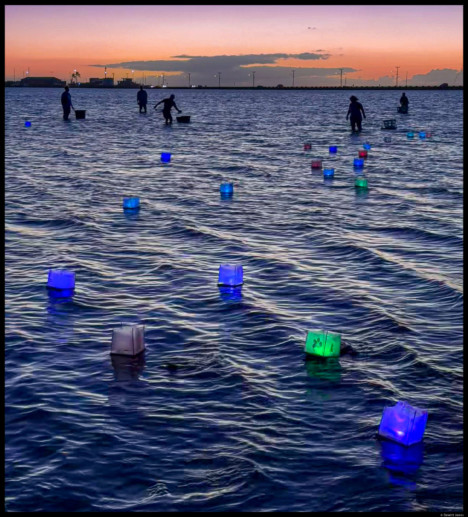10th Floating Lantern Ceremony
By Jack Kiyonaga, Editor

Photo by Dewitt Jones.
Dusk on Molokai’s southern shore brought residents together in memorial of their loved ones on Nov. 4. The 10th anniversary of the floating lantern ceremony brought a combination of sadness and celebration, with the lights of the paper vessels fading into the night along the shoreline at the Molokai Community Health Center.
Molokai’s Guzeiji Soto Mission started their floating lantern ceremony 10 years ago, in collaboration with Hospice Maui on Molokai.
“[We] thought this would be a cool event for the community to not only remember but honor loved ones,” explained Lisa Takata, president of the Guzeiji Soto Mission.
This year’s ceremony featured special lanterns commemorating the lives lost in the Maui fires, first responders like Tre’ Evans Dumaran, doctors Emmett Aluli and William Thomas, Aloha Flight 1712, and victims of suicide, among others. The special commemorative lantern for the victims of the Maui fires had 97 butterflies drawn on it, one for each life lost.
“We’re all there for a common good,” said Takata. “Remembering our loved ones, whether pets or humans. It’s a healthy part of the grieving process.”
“It takes a lot of strength and courage to come and show up and express your love,” said Melanie Dwyer, CEO of Hospice Maui, one of the partners of the event. “Helping people process grief, honoring their loved ones and remembering them…it was just really beautiful to see.”
Floating lantern, or toro nagashi, ceremonies date back over a thousand years in Japan, usually tied to Obon Festivals. The modern iteration of the ceremony became prevalent in the 1940s after the atomic bombing of Hiroshima in 1945. The following year, victims’ names were written on paper lanterns and floated down the city’s rivers.
The tragedy of the Lahaina fires was the focus of this year’s ceremony.
Hospice Maui recognized “the extraordinary efforts of the Molokai community in making countless trips by boat to bring supplies,” after the August fires, explained Dwyer.
“It brought so much hope to see neighbors and family coming together to help one another…it is an example that during the most challenging times that we are never alone and that we are stronger together,” she said.
Dwyer explained that the lantern ceremony acts as a productive grieving process.
“Doing the artwork and decorating the lantern, it’s actually considered part of a bereavement program for hospices,” she said.
The night offers the opportunity “not just to grieve, but to process, heal and celebrate,” she said. “People walk away feeling really good.”
As the lanterns floated towards Kaunakakai Wharf, figures emerged from the darkened shoreline, wading towards the lights. It was the Wa’apaemua Canoe Club, there to gather the lanterns, preventing littering.
The next event for the Guzeiji Soto Mission will be a Zen lecture and lunch, called Shojin Ryori, from 10 a.m. to 12 p.m. at the Guzeiji Soto Mission on Dec. 2.











Don't have a Molokai Dispatch ID?
Sign up is easy. Sign up now
You must login to post a comment.
Lost Password